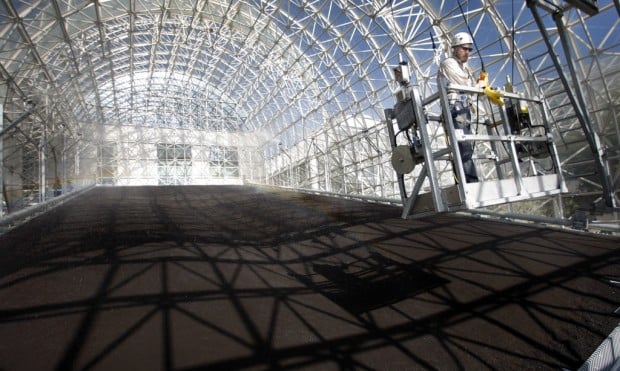The University of Arizona christened a novel earth-science experiment at Biosphere 2 last week with a gentle rain - a demonstration of how researchers will be able to vary climatic conditions on three massive indoor hillslopes loaded with sensors and samplers.
On Friday, university researchers met with colleagues from other universities and representatives of federal funding agencies to discuss what to do with its new experimental instrument - and figure out how to sustain it.
The Landscape Evolution Observatory, known as LEO, took five years to plan and build and cost about $7 million.
It consists of three identical hillslopes - 40-by-100-foot steel beds filled with volcanic soil, each weighing nearly 2 million pounds.
Each slope is studded with sensors that provide a continuous record of soil moisture, temperature and carbon dioxide concentrations. Sampling ports will allow researchers to record changes in soil chemistry as the volcanic rock weathers into soil and undergoes more change as plants are added in a year or two.
The beds rest on sensors that record weight changes as rain falls and evaporates.
In a panel discussion Friday, Jun Abrajano of the National Science Foundation compared the new scientific tool to the iPad.
When Steve Jobs announced the new Apple tablet, there was skepticism about its usefulness, he said. Abrajano, deputy assistant director for geosciences at the NSF, said he was among those who wondered, "Why do I need an iPad? I have a laptop. I have a desktop."
Similarly, he said, earth science research can now be done in the field or in controlled outside experiments. Selling LEO as a third tool to researchers and funders will be a challenge, he said. "You will meet skepticism. In fact, you already have."
Abrajano noted that his family now owns four iPads.
Russell C. Kelz, an NSF program director for instrumentation and facilities in the earth sciences, said the university will have to prove the worth of its new observatory before it can attract significant funding.
"I'm grasping for what are the scientific questions that can be asked," he said.
The questions will come, said hydrologist Ciaran Harman, an assistant professor at Johns Hopkins University.
He told the panel that LEO is "an amazing opportunity to think bigger."
Initial measurements of water movement may not be exciting, he said, but, "It's going to ramp up over time" as plants are added and interactions become more complex.
David Breshears said he's excited by LEO's potential to answer basic questions about the interactions between soil, water and plants. "It's a really different scale. You can't do that in the field or in a little pot of soil," said Breshears, a UA professor of natural resources.
Biosphere 2 Science Director Peter Troch said LEO "will allow us to observe how water and life interact at the Earth's surface."
The "thin veneer" between the groundwater table and the treetops is the zone "where life exists, where life happens," he said. "But we truly don't understand how that all works because we've always studied it from our own disciplines."
LEO seeks to attract research across a vast array of specialists, including hydrologists, geologists, chemists, biologists, ecologists and atmospheric scientists.
That collaborative culture is the way science should be done, said Leslie Tolbert, UA vice president for research.
Tolbert said LEO is appropriately named an "observatory."
"It will do for Earth science what astronomical observatories do for us in different ways," she said.
UA Dean of Science Joaquin Ruiz said LEO will help researchers answer some "grand challenge" questions, particularly in the area of climate change.
LEO is the first major addition to Biosphere 2 since the UA took over its operation in June 2007. The university was given the 3.16-acre enclosed habitat in June last year by CDO Ranching & Development, along with a $20 million gift from the Philecology Foundation headed by Edward P. Bass, who provided funding for the original construction of the Biosphere.
On StarNet: Find more science, health and technology stories, including the 2012 UA College of Science e-edition at azstarnet.com/science
DID YOU KNOW?
Biosphere 2, the 3.14-acre glass, steel and concrete enclosure outside Oracle, is the largest enclosed experiment ever built.
It was conceived by John Allen and constructed by a group called Space Biospheres Ventures, with capital supplied by Fort Worth, Texas, billionaire Edward P. Bass.
In 1991, eight Biospherians entered the habitat for a two-year experiment in enclosed living. The concrete had not totally cured and produced an atmosphere that became dangerously low in oxygen. Oxygen was pumped in, and the crew stayed for the planned two years. A second experiment in sealed-up living ended prematurely when the airlocks were opened from outside by two of the original Biospherians during a dispute over management.
Columbia University ran the giant terrarium from 1995 to 2003. The University of Arizona took over management in 2007. It accepted ownership in 2011.
Source: Arizona Daily Star archives
Contact reporter Tom Beal at tbeal@azstarnet.com or 573-4158.






